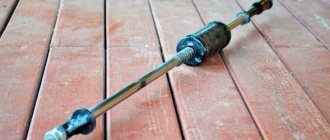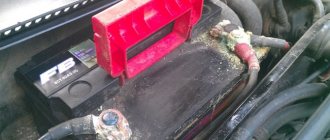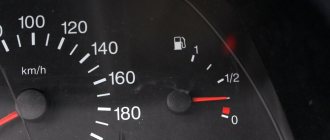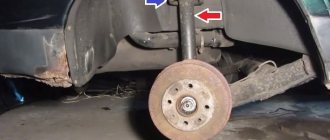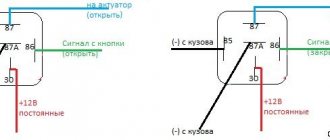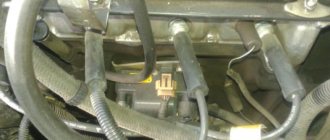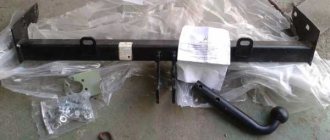Surface preparation stage
The beginning of work consists of high-quality surface preparation. In this case, loose rust and old paint are roughly cleaned with a wire brush, after which the area of damage is assessed. It is worth noting that metal never rots strictly locally. There is always a certain amount of thinned metal around the existing hole, which ideally also needs to be removed. The boundaries of this zone are determined by pressing firmly. If the metal crunches and bends when pressed by hand, it must be removed. You can cut out areas of thinned metal using a grinder with a cutting disc. After the openly rusted metal has been removed, the edges of the treated area are cleaned and leveled using sandpaper or the same grinder, but with a grinding disc. The metal around the edges of the hole should be clean and shiny. In cases where it is not possible to completely clean the edges of the hole from rust (small cavities remain), the metal is treated with an acidic rust converter. To do this, the composition is applied to the corrosion areas, time is allowed for the reaction to occur (15 - 30 minutes). After this, the converter is washed off with plenty of water, the treated area is wiped and dried. Further work must be done immediately after the initial processing. A delay of several days in most cases leads to the appearance of new foci of corrosion, which will have to be treated again.
How to repair through holes on a car body using putty without welding
Before repairing a hole in the car body, you should prepare:
- fiberglass and automotive putty;
- aluminum mesh;
- putty knife;
- sandpaper (if possible, it’s also worth looking for a sanding machine);
- primer, paint, varnish.
Fixing holes in a car body itself is distinguished by its simplicity. First of all, you should remove the rust using an angle grinder or any other suitable equipment. Next, we cut out the patch from aluminum, and then attach it to the body using masking tape. We apply a thin layer of fiberglass putty (here it is important not to touch the tape, because then you will have to remove it). When the putty sticks, peel off the tape and putty the remaining areas.
It is important that the layer is as thin as possible, without tubercles or other irregularities.
When everything is dry, sand everything using coarse sandpaper or a sander.
Having achieved a flat and smooth surface, apply a second ball of putty - automotive putty. We wait until it dries and level it again. Then the surface is primed (do not forget to cover the areas that do not require painting with film). When the primer is finished, you can paint the body.
It is worth noting that the patch will be more stable if you apply a couple of layers of putty on the back side. In addition, it is also possible to seal holes in the car body without welding using putty and without using a patch. In this case, it is necessary to apply a lining on the back side so that the composition is well fixed. On the other hand, this solution is only suitable for very small through holes.
Read more: New Toyota car models
Let's watch a detailed video on how to seal holes without welding:
Repair by caulking the hole
The simplest method is to cover the hole with epoxy resin or fiberglass putty. This repair method is perfect for small holes in inconspicuous areas of the body that are not too exposed to road factors. Before processing, the edges of the hole are rubbed with sandpaper, creating small scratches (risk), and degreased with gasoline, alcohol or acetone. After this, the hole is roughly covered with the selected composition, filling the internal cavity if possible. It is better if the hole is not completely filled. The filler level should remain a couple of millimeters below the level of the main surface. After the fiberglass putty has dried, the remaining hole is filled with all-purpose putty or finishing putty. After it dries, the surface is ground, comparing the level of the main surface with the level of the repair material. In this case, grinding is done with fine sandpaper using a wooden sanding block. The result of grinding should be such that a person, running his hand over the repair site, does not feel any bumpiness. For aesthetic purposes, the repair area can be covered with a decorative picture or primed and painted. However, it will not be possible to completely hide the site of intervention at home. To do this, it is necessary to completely repaint the body element or resort to a complex procedure of touching up the damaged area with a “spot”.
Repair by sealing the hole with metal
This repair method is somewhat more complex and requires certain tools. However, in this way it is possible to repair holes that cannot be covered with fiberglass due to their large size. To complete the work, the hole is measured. After this, a patch is cut out from a separate piece of metal, covering the hole by 1 - 2 centimeters and extending onto the area of strong metal. The patch is adjusted to the shape, the edges are aligned and cleared of sharp burrs. After this, holes are drilled along the edges of the patch, the distance between which should be about one centimeter. Before installing the patch, the area to be repaired is treated with anti-corrosion compounds and sealant. You can also process the bottom of the patch. The treated insert is pressed to the installation site and fixed. After this, they are secured using metal screws through pre-drilled holes. In this case, the fixation strength is sufficient for elements that do not undergo significant loads, and treatment with a sealant prevents moisture from penetrating through the gap. After the patch is fixed, the protruding screw heads are almost completely ground off with a grinder. However, the residual thickness of the cap should not be lower than 0.4 - 0.5 mm. Otherwise, the patch will simply fly off the fasteners. The patch itself and the adjacent area are deepened with a hammer, after which the repair area is puttied and tinted.
Car body soldering
This method is used to seal small and large holes without welding. To work, you will need flux, which will protect the metal from rapid oxidation. Soldering acid, sold in radio stores, can successfully cope with this task. To achieve the required temperature, you will need a soldering iron with a power of 1 kW or more, or a version heated with a blowtorch, but it is better to use a gas torch. The solder is chosen to be refractory, since it can be used to repair a hole in the car body more reliably.
Small holes are simply filled with solder, starting from the edges and gradually fusing to the center. A large hole in the body is covered with a patch cut from tin from a tin can. It provides:
- strong connection, almost like welding;
- significantly longer service life than putty, but less than welding;
- possibility of sealing large holes;
- ease of implementation, repairs are accessible even to beginners.
The work is performed in the following sequence:
- A patch is cut to fit the size of the hole. The larger the area of contact with the body, the more reliable the connection.
- The soldered edges of the patch and the damaged areas are cleaned with sandpaper until shiny.
- Using flux and solder, the cleaned surfaces are tinned.
- After applying the patch to the repaired area of the car, it is heated to the melting temperature of the solder. In this case, you need to ensure the continuity of the seam so that there are no missing sections.
- After cooling, the remaining flux is removed, and the soldering area is washed with hot water and soda.
Read more: Solaris 3rd generation photo
The disadvantage of this method is that the patch swells due to heating. If checking with a ruler confirms this, the bubble is removed with light blows of a hammer.
The resulting depression is leveled with putty:
- Marks are applied to the surface of the patch, plus a few millimeters from each edge, with 120-grit sandpaper. This is necessary for reliable adhesion of the putty to the metal.
- The cleaned surface is cleaned of dust and degreased with a solvent.
- To prevent the metal from becoming rusty, the primer is applied no later than an hour after preparation.
- The first 2 layers are applied with a phosphate or acid primer with an interval of 15 minutes.
- After waiting another quarter of an hour, apply 2 - 3 layers of acrylic primer at intervals of 5 minutes.
- It takes 3 - 4 hours to dry completely. The drying process can be accelerated using an infrared heater.
Repair by welding the hole
This method is the most correct of all listed. In this case, the patch is fixed not with screws, but by welding. This can be done with points through drilled holes. This makes the fastening more durable and invisible. After completing the welding work, the patch is also recessed and puttied. To carry out welding work on a car, it is better to use semi-automatic welding. Working with an arc inverter is also possible, but the welding seam is rougher and requires significant subsequent processing. In addition, thin automotive metal simply burns through under the influence of the electrode.
End of work
Before puttying, it is necessary to apply a layer of anti-corrosion primer or rubber-bitumen mastic to the fixed patch. The putty is applied only after it has completely dried and been treated with sandpaper to create a scratch. For puttying, a universal putty or several types of specialized putty can be used. After the applied compounds have dried, the area is ground to ensure a perfect match between the main and repair surfaces. Before touch-up, the area is degreased and another layer of anti-corrosion primer is applied. After it dries, tinting is done in several layers. Metallic paints must also be coated with clear varnish. This is done until the paint has completely dried, 15 - 20 minutes after applying its last layer. To make the repair area less noticeable, paint is applied without masking tape, avoiding the appearance of a clear boundary of the painted area. This makes the transition smoother. It is necessary to seal only those areas where you do not want paint to come into contact (glass, door handles, headlights, chrome elements).
Algorithm for carrying out the process of eliminating a through hole by applying a patch with a soldering iron
Here's what to do:
- To begin with, it is recommended to thoroughly clean the rust from the corrosive area. You can use attachments and a drill (also another set of tools).
- A patch is cut from a piece of metal sheet. An option is to use a can of auto chemicals, etc.
The patch must cover the entire hole on the vehicle frame element.
- A powerful soldering iron is prepared, with which the patch is applied.
It is also recommended to use anti-rust compounds, otherwise called orthophoric acid. Another help will be the use of tin solder.
- Now you need to tin the edges of the patch.
Particular attention is paid to the edges of the hole where the patch will be placed.
- A piece of metal is soldered with a continuous seam.
- It is checked by measuring whether the patch does not protrude above the surface of the body like a bubble.
You can diagnose the protrusion using a flexible ruler.
- The protrusion (if detected) is recessed with gentle blows of the hammer.
Once the patch is recessed, there is bound to be a small gap. It will need to be leveled using putty. We must not forget that the thickness of the putty layer should not exceed 2-3 mm. Otherwise, the layer will crack easily after drying.
- Before puttying, the surfaces are properly prepared: the rust is cleaned off with a metal brush, and then sanded.
It is better to use 120-grit sandpaper. We must not forget that the matting area should be larger than the area directly being puttied.
- An abrasive mark is applied to the surface. This is done so that the putty has something to hold on to.
- Now you need to treat all areas with a degreaser after sanding.
- The surfaces must be primed first. This is done no later than an hour after sanding, since cleaned metal without paintwork quickly undergoes oxidation processes.
It is better to take a phosphate primer as the first layer. This type of primer is a 2-component composition that is easily diluted with water.
Attention. It is prohibited to dilute phosphate primer in a metal container. The fact is that phosphate tends to interact with iron, and this is not good. It is better to use a glass or plastic container.
If you can’t find a phosphate primer, aerosol KSL primer in cans is also an option.
It is recommended to apply the first primer in 1-2 layers, directly onto bare metal. It dries quickly, but due to its liquid state it can cause smudges.
As soon as 10-15 minutes have passed after applying the first primer, you must proceed to treating the surface with acrylic. This type of primer is applied in 2-3 layers. The gap between layers is maintained for about five minutes.
Note. Again, acrylic primer can successfully replace the composition of an AER spray can. This is especially true if there is no compressor.
Acrylic dries completely within 3-4 hours. If it is possible to use INFR heating, the drying period can be significantly reduced.
All that remains is to putty the surface, then sand and prime.
The method of sealing a through hole using a patch is considered the most rational for a number of reasons.
- Soldered patches last much longer than just fiberglass putty.
- The patch provides a more reliable connection.
- You can close holes of almost any size (except for too large ones, when only the service of specialists is relevant).
- Simplicity of technology. Even a beginner can handle the job.
Video on how to seal a through hole
Some tips for choosing paint
The choice of paint is a huge topic, which is not possible to cover in the format of one of the sections of this article. However, here are some of the most relevant tips for running this event yourself. 1. The cost of selecting and creating paint that exactly matches the color of the car is quite high. In different workshops it can vary from 3 to 5 – 6 thousand rubles per kilogram. However, when repairing old cars, it is not at all necessary to tint them with exactly the same paint. In most cases, it is enough to remove the hatch (the only painted part, the removal of which takes no more than a minute) of the gas tank and bring it to the store. Sellers will easily select paint using special color sheets. This paint will have minimal differences from the original paint of the car, not noticeable without close inspection. 2. To select paint, you should not take painted plastic elements with you to the store. Due to the characteristics of the material, the paint on them can differ quite significantly from that on the metal parts of the body. 3. It is better to use spray paint. This is especially true for painting large areas. Minor damage can be touched up using a spray can, but the coating layer will be thin and will not last long. 4. Don't look for the cheapest paint. Such compositions rarely turn out to be of high quality. A small overpayment will allow you to get a more durable layer of paintwork on the damaged area.

